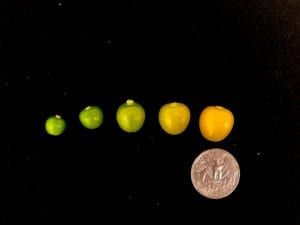Physalis Blog Post
Biology Minute: Fruit Ripening
The fruit ripening process is a crucial stage of fruit development, as it results in an edible and more attractive fruit for consumption. Fruits that ripen as a result of a sharp increase in respiration and ethylene production are classified as climacteric fruit, and continue to ripen once picked. Physalis peruviana and Physalis pruinosa are both climacteric fruits, with one study (Trinchero et al. 1998) recording a 45-fold increase of ethylene in peruviana during the ripening stage. As a result of this influx of phytohormone (ethylene), responses such as fruit softening and color changes are observed.
Due to the ethylene sensitivity climacteric fruits exhibit, once ripening occurs the fruit must soon be consumed to avoid quality degradation. To avoid this issue, many climacteric fruits are harvested unripe, and then later treated with ethylene when ready for consumption. A common example of this practice is with bananas. Physalis are unique in that they have a husk, which has been shown to reduce ethylene production, however once the husk is removed, the rate of respiration and ethylene production increases. Therefore, large exporters of Physalis will ship the fruit with the husk intact for both protective and physiological reasons (Yahia 2011).
| Climacteric Fruit | Non-climacteric Fruit |
| Banana | Grapefruit |
| Apple | Raspberry |
| Physalis | Strawberry |
| Pear | Grapes |
| Peach | Orange |


